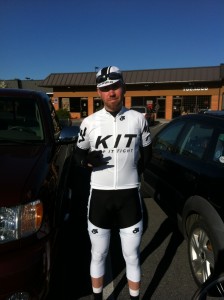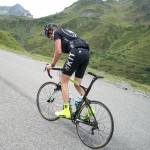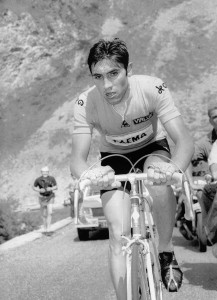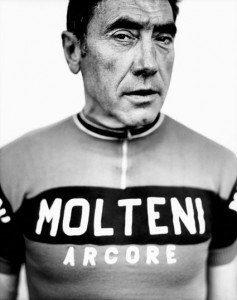
Sports: Cycling, Bouldering, Trail Running, Skateboarding
Favorite Event: Northampton Cross and Sterling Road Race
Strengths: Above average Microsoft Excel Skills, so, a detailed analysis of performance after hammer was put down. Complete with pie chart and/or bar graph.
Entry into endurance sports: I bought my first bicycle with gears on my 30th birthday, started with the Maine Time Trial Series the following year.
Years competing in endurance sports: 5
By guest KIT blogger, Dave Andersen

Endurance sports require humility and patience. We all start with baby steps and then gradually move forward in our athletic journey. Some move forward rapidly, others, one step at a time. No matter how fit you are, if you are going to be an endurance athlete—at least in my experience—you better be able to eat humble pie. Here’s a quick story…
The Journey Becomes Our Lifestyle
Back in high school when I was a year or two into my running “career” my little brother decided he wanted some of the fun. So he joined me at a 7 mile road race and proceeded to beat me. That was my introduction to the fact that some people have a genetic gift (high VO2 max, etc) and their steps forward are bigger. While I was pretty happy to run sub 10-minutes for 2 miles in high school, my little brother was about 1-minute faster. Years later his sub 2:30 marathon would drive the point home.
So, really the goal for 99% of us (nonprofessional athletes) is to have fun and, given our physical and time limitations, try and reach our own personal limits. That being done, we must be satisfied. I know I am. I’ll go a step further and say it’s the journey (training) which becomes our lifestyle, which is perhaps most rewarding and brings a rare quality of life. Sure a solid race performance underlines all the hard work and sacrifice, but they are often far and few between.
The bottom line is: those of us that can follow our passion for fitness, sport, or even regionally high-level racing should never take it for granted or put too much expectation upon ourselves. Work as hard as you can without sacrificing your job, family, etc. It is a gift to do what we do and in the context of a balanced lifestyle it doesn’t really matter if you make the podium or come in with the pack. Do the best with what you have and be satisfied. Then flip on the internet and watch Tom Boonen riding away, while you dream away.Tom Boonen 2012 Paris Roubaix
KIT!
——————-
*Dave Andersen lives in Boston and works in the educational publishing business. He shares his passion for cycling and sport with a wide range of friends and competitors.
By guest KIT blogger, Dave Andersen

Most of us first learn to ride a bicycle as young kids. Riding a bike is so simple even toddlers can do it. Yet serious cycling and especially bike racing are anything but simple. Or are they? Many folks labor over bike fit, wheels, heart rate monitors, power meters, and training plans. Granted, some of this stuff has it’s place, but at the essence we are turning the pedals and just trying to keep up with our fellow riders.
Good Enough for The Cannibal
While some of my competitors are dropping thousands of dollars on power meters to go on their already expensive bikes I made the decision to train and race by feel and sensation. If it was good enough for Eddy Merckx (see below), it’s good enough for me. Training is or can be a complex mix of distance, intervals, group rides and periodization. Racing is all about pack skills and keeping up. Either you can keep up or you can’t. I don’t need a heart rate monitor or a power meter to tell me I’m suffering or getting dropped. And if I can’t keep up it’s because the other guys are stronger.


Hey, I’m not anti-technology! I like the internet and carbon fiber, and I like having folks with their map-equipped Garmin’s along when riding in some far flung locale. I have simple cyclometers mounted on some of my bikes, but I usually only look at the data after I’m done riding, to see how far I went. When I do intervals or hill repeats I use a stop watch. In a race I never look at the data, or if I did glance at my cyclometer it would be to see how much farther we have to go, but then again, what does it matter? The object of the race (Winning? Having fun?) is to keep up for as long as possible, preferably, right to the finish line.
Kudos to those that utilize these advanced technological tools successfully, but I’m going to keep my cycling simple; I’m going to look outward (where I’m going) and inward (monitoring my sensations).
If you don’t agree with me, I refer you to RULE #74:
“Rule #74: V Meters or small computers only.
Forgo the data and ride on feel; little compares to the pleasure of riding as hard as your mind will allow. If you are not a Pro or aspire to be one, then you don’t need a SRM or PowerTap. To paraphrase BSNYC, an amateur cyclist using a power meter is like hiring an accountant to tell you how poor you are. As for Garmins, how often do you get lost on a ride? They are bulky, ugly and superflous. Cycle computers should be simple, small and mounted on the stem. And preferably wireless.”
To the folks at SRM (if you happen to read this): you might change my mind about technology by setting me up with the SRM SRAM S975 Powermeter System
(retail: $3,845.00). Jussayin!
In the meantime, keep it tight (and simple).
——————-
*Dave Andersen lives in Boston and works in the educational publishing business. He shares his passion for cycling and sport with a wide range of friends and competitors.